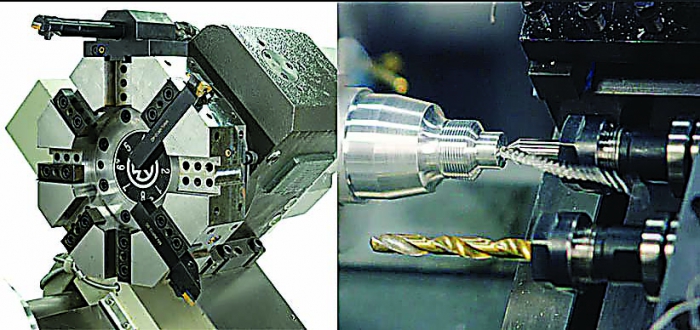Selecting a turret or gang tooling for a CNC lathe
Selecting a turret or gang tooling for a CNC lathe
Deciding whether to use a turret or gang tooling is one of many topics that seems to engender religious fervor from one side to the other. Let's start by providing a brief overview of each approach and then dive into the details.
Deciding whether to use a turret or gang tooling is one of many topics that seems to engender religious fervor from one side to the other. Let's start by providing a brief overview of each approach and then dive into the details.
Pure gang tooling is the simplest option for a CNC lathe. The tools sit in a row on the lathe's cross-slide. To change a tool, an end user takes the following steps:
- Pulls the current tool from the workpiece with a Z-axis motion.
- Slides in the X-axis until the new tool is in position.
- Moves along the Z-axis to start cutting.
A tool turret is more complex than simple gang tooling. A turret holds a group of tools and rotates to bring a new cutting tool into position. Changing tools involves:
- Pulling the current tool back, typically with a Z-axis or combined X- and Z-axis motion.
- Rotating the turret until the correct tool is in position.
- Bringing the tool forward to begin cutting, again with a Z or XZ motion.
Lathe turrets are like the rotary toolchangers familiar to users of CNC milling machines.
Which one is better?
| Turret pros | Gang pros |
|---|---|
| More flexible | Faster tool changes |
| Handles longer, skinnier parts | Simpler |
| Handles larger diameter parts | Lower cost |
| Easier to program | Faster setup |
| Accommodates more tools | More accurate |
| More possible axes | More Reliable |
Here's the top-level conclusion:
Choosing between gang tooling and a turret on a CNC lathe should be based on the kinds of parts being machined:
- Gang tooling is very hard to beat for small-diameter, short parts that do not need a tailstock.
- Turrets are more versatile. They are a must for long, skinny parts that need a tailstock for support.
Many machinists wish they could use their gang lathes for everything, but they have turret machines for parts that are too long and thin to be made with a gang lathe.

A CNC lathe with a turret (left) and gang tooling (right). Image courtesy of B. Warfield
For those kinds of parts, perhaps a better "competition" would be gang lathes vs. Swiss-style machines. Another possibility is to install small gang plates in some of the turret stations. This adjustment can make tool changes very fast for the tools on that station.
Turrets are also the norm on larger CNC lathes and multifunction machines. Turrets are preferred for large work because they don't require clearance under the part. The turret can approach the part from behind, which allows more room for large-diameter parts.
Multifunction machines use multiple turrets and spindles to greatly enhance the speed and flexibility of the machine. The goal is to perform all operations in a single setup. With two spindles, the part can be transferred to a second spindle to allow machining of the back side. With multiple turrets, more tools can be accommodated, parts on two spindles can be machined simultaneously (one turret per spindle), and it's even possible to increase the mrr by roughing an OD with two tools in one pass.
At the high end, the flexibility of turrets makes them the winner. At the lower end, the simplicity and speed of gang tooling makes them the winner.
An in-depth article about turrets vs. gang tooling is available on the CNCCookbook blog (tinyurl.com/y7372pe5).





